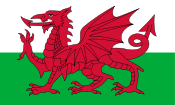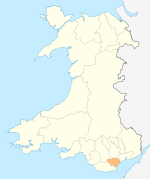- Welsh Government
-
Welsh Government
Llywodraeth Cymru
Logo of the Welsh Government Government overview Formed 1999 Jurisdiction Wales Headquarters Crown Buildings, Cathays Park, Cardiff, Wales Employees 5,100 Annual budget £15.285 billion (2010/11) Minister responsible Carwyn Jones AM,
First MinsterGovernment executive Dame Gillian Morgan, Permanent Secretary Website www.wales.gov.uk The Welsh Government (Welsh: Llywodraeth Cymru) is the devolved government of Wales. It is accountable to the National Assembly for Wales, the legislature which represents the interests of the people of Wales and makes laws for Wales. The National Assembly for Wales was created by the Government of Wales Act 1998.
The Welsh Government and the National Assembly for Wales were established as separate institutions under the Government of Wales Act 2006. The Government is referred to in that Act as the Welsh Assembly Government, but to prevent confusion about the respective roles and responsibilities of the National Assembly and the Government, the devolved administration became known as the Welsh Government in May 2011,[1] following the precedent set by the Scottish Government re-name in 2007.
The Welsh Government consists of the First Minister, usually the leader of the largest party in the National Assembly for Wales; up to twelve ministers and deputy ministers, appointed by the First Minister; and a Counsel General, nominated by the First Minister and approved by the National Assembly.
The current First Minister is Carwyn Jones, formally appointed by the Queen on 12 May 2011, who appointed ten ministers and deputy ministers. The Counsel General is Theodore Huckle.
1999 to 2007 (Executive Body of the National Assembly)
Wales 
This article is part of the series:
Politics and government of
WalesGovernmentWales in the UKWales in the EUSubdivisons
As initially established, the Welsh Government had no independent executive powers in law (unlike, for instance, the Scottish Ministers and Ministers in the UK Government). The National Assembly was established as a body corporate by the Government of Wales Act 1998 and the executive, as a committee of the Assembly, only had those powers that the Assembly as a whole voted to delegate to Ministers.
The Government of Wales Act 2006 formally separated the legislature (National Assembly for Wales) and the Welsh Government, giving Welsh Ministers independent executive authority, this taking effect after the May 2007 elections. Following separation, the Welsh Ministers exercise functions in their own right. Further transfers of executive functions from the UK Government can be made directly to the Welsh Ministers (with their consent) by an Order in Council approved by UK Parliament.
Separation was designed to clarify the respective roles of the legislature and the executive. Under the structures established by the Government of Wales Act 2006, the role of Welsh Ministers is to make decisions; develop and implement policy; exercise executive functions and make statutory instruments. The 60 Assembly Members in the National Assembly scrutinise the Government’s decisions and policies; hold Ministers to account; approve budgets for the Welsh Government’s programmes; and enact Assembly Acts on subjects within devolved legislative competence.
The result mirrored much more closely the relationship between the UK Government and UK Parliament and that between the Scottish Government and the Scottish Parliament.
Post-National Assembly for Wales Election, 2007
Legal Separation
The new arrangements provided for in the Government of Wales Act 2006 created a formal legal separation between the National Assembly for Wales, the legislature comprising the 60 Assembly members, and the Welsh Government, the executive, comprising the First Minister, Welsh Ministers, Deputy Welsh Ministers and the Counsel General. This separation between legislature and executive took effect on the appointment of the First Minister by Her Majesty the Queen following the Assembly election on 3 May 2007.
Separation should help to clarify the respective roles of the legislature and the executive. The role of the executive is now to make decisions; develop and implement policy; exercise executive functions and make statutory instruments. The 60 Assembly members in the National Assembly scrutinise the Welsh Government’s decisions and policies; hold Ministers to account; approve budgets for the Welsh Government’s programmes; and have the power to enact Assembly Measures on certain matters. Assembly Measures can now go further than the subordinate legislation which the Assembly had the power to make prior to 2007.
Transfer of Functions
The Assembly’s functions, including those of making subordinate legislation, in the main, transferred to the Welsh Ministers upon separation. A third body was also established under the 2006 Act from May 2007, called the National Assembly for Wales Commission. It is responsible for employing the staff supporting the new National Assembly for Wales and for holding property, entering into contracts and providing support services on its behalf.
Welsh Ministers
The 2006 Act made new provision for the appointment of Welsh Ministers. The First Minister will be nominated by the Assembly and then appointed by Her Majesty the Queen. The First Minister subsequently appoints the Welsh Ministers and the Deputy Welsh Ministers, with the approval of Her Majesty. The Act created a new post of Counsel General for Wales, the principal source of legal advice to the Welsh Government. The Counsel General is appointed by the Queen, on the nomination of the First Minister, whose recommendation will need to be agreed by the National Assembly. The Counsel General may be, but does not have to be, an Assembly Member. The Act permits a maximum of 12 Welsh Ministers, which includes Deputy Welsh Ministers, but excludes the First Minister and the Counsel General. Accordingly, the maximum size of the Welsh Government is 14.
Referendum on law-making powers for the National Assembly for Wales
Functions and areas of competence
Following the yes vote in the referendum on further law-making powers for the Assembly on 3 March 2011, the Welsh Government’s functions now include being able to propose Bills to the National Assembly for Wales on subjects within twenty fields of policy. Subject to limitations prescribed by the Government of Wales Act 2006, Acts of the National Assembly may make any provision that could be made by Act of Parliament. The 20 areas of responsibility devolved to the National Assembly for Wales (and within which Welsh Ministers exercise executive functions) are:
- Agriculture, fisheries, forestry and rural development;
- Ancient monuments and historical buildings;
- Culture;
- Economic development;
- Education and training;
- Environment;
- Fire and rescue services and promotion of fire safety;
- Food;
- Health and health services;
- Highways and transport;
- Housing;
- Local government;
- National Assembly for Wales;
- Public administration;
- Social welfare;
- Sport and recreation;
- Tourism;
- Town and country planning;
- Water and flood defences;
- Welsh language.
Department of the First Minister & Cabinet
The Department of the First Minister & Cabinet is in Tŷ Hywel and the Senedd in Cardiff Bay, however, an office is also kept at the Welsh Government building in Cathays Park where the majority of Cardiff-based Welsh Government civil servants are located.
Offices
The Welsh Government has a total of 86 offices throughout Wales,[2] and a number overseas.[3] Traditionally, most Welsh Office staff were based in Cardiff, especially in Cathays Park. However, in 2002, the Fullerton Review concluded that "the Assembly could no longer sustain having the majority of its operational functions located in and around Cardiff."[4] Since 2004, Welsh Government civil servants have been relocated across Wales as part of the Location Strategy, which involves the creation of new offices at Merthyr Tydfil, Aberystwyth and Llandudno Junction.[5] In 2006, the mergers of ELWa, the Wales Tourist Board and the Welsh Development Agency into the Welsh Government brought these agencies' offices into the Welsh Government estate.
Current Welsh Government
Main article: List of Welsh GovernmentsThe current structure of the ministerial team is formed by Welsh Labour.
Cabinet
Office Name Term Party First Minister Rt. Hon Carwyn Jones AM 2011– Labour Minister for Finance and Leader of the House Jane Hutt AM 2011– Labour Minister for Business, Enterprise, Technology & Science Edwina Hart AM 2011– Labour Minister for Education and Skills Leighton Andrews AM 2011– Labour Minister for Environment & Sustainable Development John Griffiths AM 2011– Labour Minister for Health and Social Services Lesley Griffiths AM 2011– Labour Minister for Housing, Regeneration & Heritage Huw Lewis AM 2011– Labour Minister for Local Government & Communities Carl Sargeant AM 2011– Labour Office holders given special provisions to attend Cabinet Chief Whip Janice Gregory AM 2011– Labour Counsel General for Wales Theodore Huckle QC 2011– Labour Deputy Ministers
Office Name Term Party Deputy Minister for Children & Social Services Gwenda Thomas AM 2011– Labour Deputy Minister for Skills Jeff Cuthbert AM 2011– Labour Deputy Minister for Agriculture, Food, Fisheries & European Programmes Alun Davies AM 2011– Labour Welsh Government Home Civil Service
Permanent Secretary
The Permanent Secretary heads up the Civil Service of the Welsh Government and chairs the Strategic Delivery and Perormance Board.
The Permanent Secretary is a member of the Home Civil Service, and therefore takes part in the Permanent Secretaries Management Group of the UK Civil Service[6] and is answerable to the most senior civil servant in the UK, the Cabinet Secretary, for her professional conduct. She remains, however, at the direction of the Welsh Ministers.
- Sir Jon Shortridge KCB (May 1999 to April 2008)
- Dame Gillian Morgan DBE (from May 2008)
Directorates
- Department of Business, Enterprise, Technology & Science
- Department of Education & Skills
- Department of Health, Social Services & Children
- Department of Local Government & Communities
- Directorate of People, Places and Corporate Services
- Directorate of Strategic Planning, Finance and Performance
- Directorate of Sustainable Futures
- Non-Directorate Services
- Legal Services
- Permanent Secretary's Division
- Department of the First Minister & Cabinet
Strategic Delivery & Performance Board
The Strategic Delivery & Performance Board translates the strategic direction set by the Welsh Cabinet and its Committees into work that is joined up across Welsh Government departments and makes the best use of its resources. The Board is made up of 7 Directors General and 2 Non-executive Directors, and is chaired by the Permanent Secretary, Dame Gill Morgan.
Strategic Delivery and Performance Board members are appointed at the discretion of and by the Permanent Secretary. Membership is not wholly dependent on functional responsibilities; it is designed to provide balanced advice and support to the Permanent Secretary, and collective leadership to the organisation as a whole. [7]
Position Name Permanent Secretary Dame Gillian Morgan DBE Director General, Strategic Planning, Finance & Performance Michael Hearty Director General, Education & Skills Dr. Emyr Roberts Director General, Business, Enterprise, Technology & Science James Price Director-General, Health, Social Services & Children and Chief Executive of NHS Wales David Sissling Director General, Local Government & Communities Dr. June Milligan Director General, Sustainable Futures Clive Bates Director General, People, Places and Corporate Services Bernard Galton Non-Executive Director Elan Closs Stephens Non-Executive Director James Turner Welsh Government sponsored bodies
Main article: Welsh Government sponsored bodiesThe Welsh Government is responsible for a number of Welsh Government sponsored bodies. These are respectively, Non-departmental public bodies. These include executive WGSBs (e.g. Arts Council of Wales); advisory WGSBs (e.g. Historic Buildings Council for Wales); and tribunals (e.g. Mental Health Review Tribunal for Wales). These are staffed by public servants, rather than civil servants. The Welsh Government is also responsible for some public bodies which are not classed as Welsh Government sponsored bodies, such as NHS Wales, the Welsh Offices of England and Wales legal offices and other institutes.
See also
- List of Wales-related topics
- Government spending in the United Kingdom
References
- ^ BBC News, Wales, 13 May 2011
- ^ Management Board Meeting, 29th February 2008
- ^ Welsh Assembly Government | All offices
- ^ Welsh Government | Update on Location Strategy
- ^ Welsh Government | Location Strategy
- ^ [1] Civil Service. PSMG Membership.
- ^ http://wales.gov.uk/about/civilservice/managementstructure/sdpb/membership/?lang=en
External links
Categories:- Politics of Wales
- Economy of Wales
- Welsh Government
- Organisations based in Cardiff
- 1999 establishments in Wales
Wikimedia Foundation. 2010.


